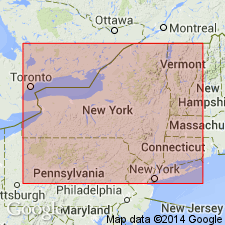
- Usage in publication:
-
- Little Beards Creek phosphate bed
- Modifications:
-
- Named
- Dominant lithology:
-
- Mudstone
- AAPG geologic province:
-
- Appalachian basin
Summary:
Windom Shale Member of Moscow Formation reaches a maximum thickness of 60 m in the eastern Finger Lakes area of NY. Here it consists of medium to dark gray fossiliferous mudstones and shales with thin concretionary limestone beds and can be divided into approximately 15 major traceable units and a number of thin, localized shell-rich beds. At the base of the Windom is a cryptic disconformity marked by small, black, phosphatic nodules and fossil steinkerns. This horizon is here informally designated the Little Beards Creek phosphatic bed. Bed has been traced from western Erie Co., where it overlies the Tichenor Member, eastward to an unnamed tributary of Hemlock Outlet Creek at Frost Hollow west of Honeoye Valley. Between Chenango Valley and Bristol Valley it overlies the Geer Road bed of the newly recognized but yet unnamed member of the Moscow. Underlies 2 to 10 m of soft medium gray, slightly pyritic, but nonconcretionary shales containing an abundance of the brachiopod AMBOCOELIA UMBONATA, and therefore referred to as the AMBOCOELIA beds. Age is Middle Devonian (Givetian).
Source: GNU records (USGS DDS-6; Reston GNULEX).
For more information, please contact Nancy Stamm, Geologic Names Committee Secretary.
Asterisk (*) indicates published by U.S. Geological Survey authors.
"No current usage" (†) implies that a name has been abandoned or has fallen into disuse. Former usage and, if known, replacement name given in parentheses ( ).
Slash (/) indicates name conflicts with nomenclatural guidelines (CSN, 1933; ACSN, 1961, 1970; NACSN, 1983, 2005, 2021). May be explained within brackets ([ ]).

